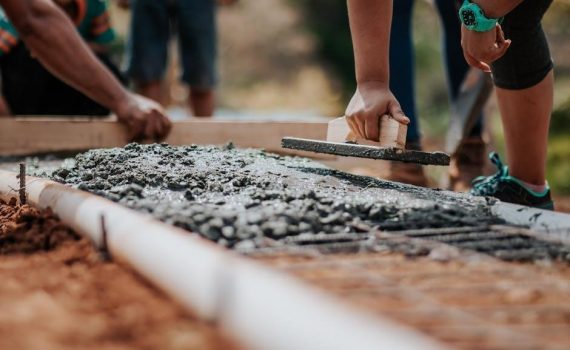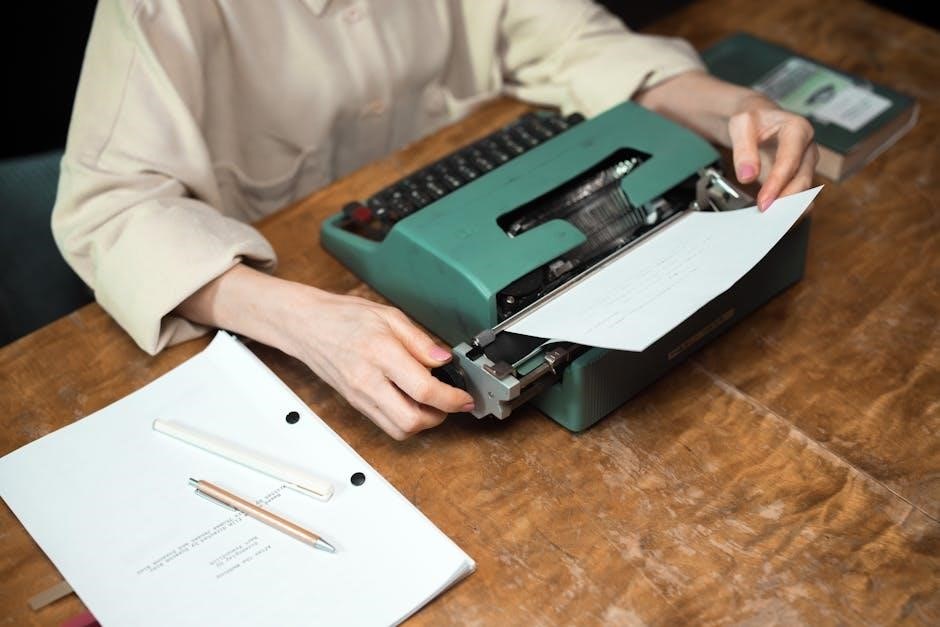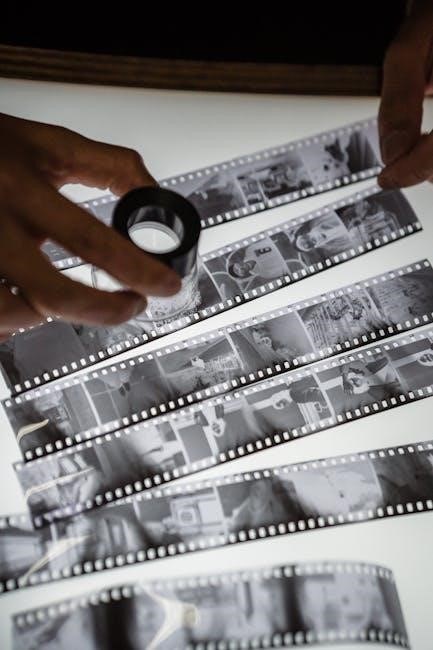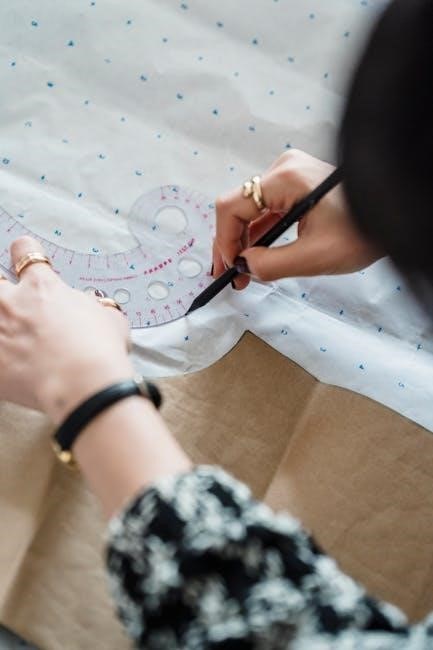one handed dressing techniques pdf
Category : PDF
One-handed dressing techniques empower individuals with limited dexterity to maintain independence. These methods, using adaptive clothing and tools, help overcome challenges, fostering confidence and self-reliance in daily tasks.
Overview of the Importance of Independence in Dressing
Independence in dressing is crucial for maintaining self-esteem and overall well-being. For individuals with limited dexterity, mastering one-handed techniques can significantly reduce frustration and reliance on others. This autonomy allows individuals to participate fully in daily activities, fostering a sense of control and confidence. Dressing independently also promotes mental health by reducing feelings of dependency and isolation. Adaptive clothing and tools can further enhance this process, making it more manageable and efficient. By gaining independence in dressing, individuals can focus on other aspects of their lives, leading to a more fulfilling and empowered lifestyle.
Who Can Benefit from One-Handed Dressing Techniques?
One-handed dressing techniques are beneficial for individuals with limited dexterity due to injury, paralysis, amputation, or chronic conditions. These methods also assist those recovering from surgery or stroke, helping them regain independence. Additionally, adaptive techniques are useful for older adults with mobility challenges and caregivers seeking to support loved ones. The strategies are versatile, addressing various needs and promoting self-reliance in personal care. By leveraging these techniques, individuals can overcome daily dressing challenges, enhancing their quality of life and confidence.

Preparation for One-Handed Dressing
Preparation involves selecting adaptive clothing, organizing a supportive environment, and utilizing assistive devices. These steps ensure efficiency and ease, making the dressing process more manageable and stress-free.
Choosing Adaptive Clothing
Adaptive clothing is designed to simplify dressing for individuals with limited dexterity. Features such as magnetic buttons, Velcro closures, and elastic waistbands reduce the need for fine motor skills. These garments often have easy-to-grasp zippers and one-handed fastening systems, making them ideal for those with mobility challenges. Additionally, clothing with stretchy fabrics allows for easier movement and comfort. Occupational therapists often recommend these options to enhance independence. By selecting the right adaptive clothing, individuals can dress more efficiently and confidently, minimizing frustration and maximizing autonomy in their daily routines. This approach not only aids in physical comfort but also supports emotional well-being by promoting self-reliance.
Using Assistive Devices for Dressing
Assistive devices are essential tools for individuals learning one-handed dressing techniques. Devices like dressing sticks, reachers, and shoe horns can significantly simplify the process. A dressing stick typically features hooks or clips to help pull up pants or skirts, while reachers assist with picking up items from the floor. Shoe horns are invaluable for slipping on shoes without bending. Additionally, buttonhooks are designed to aid in fastening buttons with one hand. These tools extend reach, reduce strain, and enhance independence. By incorporating assistive devices, individuals can perform dressing tasks more efficiently and confidently. They are particularly beneficial for those with limited mobility or strength, making daily routines easier and less frustrating.

Creating a Supportive Environment for Dressing
A supportive dressing environment plays a crucial role in facilitating one-handed dressing techniques. Ensure the space is well-lit to enhance visibility, and consider using a sturdy chair or bench for stability. Keep the floor clear of clutter to prevent tripping hazards and allow easy movement. Organize clothing in an accessible manner, such as using shelves or bins within reach. Placing essential items like socks or undergarments in easy-to-access locations can save time. Additionally, mirrors can help individuals monitor their progress without strain. A calm and uncluttered environment reduces stress, making the dressing process more manageable. By tailoring the space to individual needs, one-handed dressing becomes safer and more efficient, fostering independence and confidence.
Upper Body Dressing Techniques
Mastering upper body dressing with one hand involves slipping on shirts, sweaters, or jackets, and managing buttons, zippers, and sleeves. Using the mouth to assist with alignment and adjustments can simplify the process. Techniques focus on minimizing frustration while maximizing independence, ensuring clothing is properly positioned and secure. Practice and patience are key to refining these skills and building confidence in dressing efficiently.
Putting on a Button-Up Shirt with One Hand
Putting on a button-up shirt with one hand requires careful coordination and strategic use of adaptive techniques. Start by holding the shirt with the front facing you, using your mouth to stabilize it if needed. Slide your arm into the sleeve, pulling the shirt over your shoulder with your hand. Use your teeth to guide buttons into alignment, then secure them starting from the bottom up. For tougher buttons, consider using a button hook or adaptive tool. Practice this method to build muscle memory and confidence. Over time, this technique becomes second nature, enhancing your ability to dress independently and efficiently.
Mastering the Pullover Shirt with One Hand
Mastering the pullover shirt with one hand involves strategic movements and balance. Start by holding the shirt with the front facing you, using your mouth to stabilize the neckline if necessary. Slip your dominant arm into the sleeve first, then use your hand to guide the shirt over your head. For the other arm, carefully maneuver the sleeve over your shoulder, using your teeth to help position it if needed. Smooth, continuous movements are key to avoid struggling. Practice this technique to improve coordination and confidence. For tighter shirts, consider stepping into them or using adaptive tools like a reacher. With patience, pullover shirts can become a manageable part of your one-handed dressing routine.
Techniques for Fastening Buttons with One Hand
Fastening buttons with one hand requires precision and patience. Start by holding the garment steady with your body or a supportive surface. Use your dominant hand to grasp the button and align it with the buttonhole. To secure it, pinch the button between your thumb and index finger, then guide it through the hole using a gentle pushing motion. For smaller buttons, consider using adaptive tools like a button hook, which can simplify the process. Alternatively, try the “loop-and-pull” method: loop the buttonhole over the button, then pull it through. Practice this technique on different types of buttons to build dexterity and confidence. Over time, buttoning becomes a manageable task, enhancing your independence in dressing.
Putting on a Jacket or Sweater with One Hand
To put on a jacket or sweater with one hand, start by holding the garment with the opening facing you. Use your free hand to pull one side over your shoulder, then use your mouth to help guide the other side. For pullover sweaters, hold the bottom of the garment with your hand and slide it over your head, using your chin to help push it down. If seated, place the jacket on your lap and slide one arm in at a time, adjusting as needed. Adaptive jackets with magnetic closures or elastic hemlines can simplify the process. Practice this method while standing or sitting to find what works best for you. Patience and consistent practice will make this task more manageable over time.

Lower Body Dressing Techniques
Mastering lower body dressing with one hand involves balancing, using adaptive tools, and strategic clothing choices. Techniques include sitting for stability, using the mouth to assist, and selecting elastic waistbands for ease. Prioritize garments with simple closures or magnetic fastenings to streamline the process. Always maintain a steady posture to prevent accidents. Regular practice enhances coordination and confidence. Ensure the environment is clear of obstacles for safe movement. Using assistive devices like dressing sticks can aid in pulling up pants or skirts. Consider adaptive footwear with slip-on designs to minimize effort. Stay patient and adapt methods to suit personal comfort and mobility levels. Over time, these strategies become second nature, fostering independence.
Putting on Pants or Skirts with One Hand
Putting on pants or skirts with one hand requires coordination and the right techniques. Start by sitting comfortably and gathering the garment. Use your dominant hand to hold the waistband, while your mouth or the other arm assists in balancing. For pants, slide one leg in at a time, ensuring the fabric aligns properly. Skirts can be managed by holding the waistband with one hand and using the other arm or mouth to guide the material over your hips. Adaptive clothing with elastic waistbands or magnetic closures simplifies the process. Practice the “sitting method” for better control, and consider using assistive devices like dressing sticks for added ease. Smooth, non-slip fabrics are ideal to prevent bunching. Patience and consistent practice will enhance your ability to dress independently and efficiently.
Techniques for Zipping and Buttoning with One Hand
Zipping and buttoning with one hand can be challenging but manageable with the right techniques. For zippers, use your thumb and index finger to grip the tab, then slide it up or down. If the zipper is small, consider using your mouth to hold it in place while maneuvering. For buttons, place the buttonhole over the button using one hand, then slide it through. Adaptive clothing with larger buttons or magnetic closures can simplify this process. Practice the “pinch and slide” method for zippers and use your shoulder or chin to stabilize fabric while buttoning. Using assistive tools like buttonhooks or zipper pulls can also enhance efficiency. Regular practice will improve dexterity and speed, making these tasks more manageable over time.
Putting on Shoes with One Hand
Putting on shoes with one hand requires creativity and practice. Start by sitting comfortably and holding the shoe with your usable hand. Use your mouth to hold the shoe in place while sliding your foot into it. For lacing shoes, consider elastic laces that eliminate the need for tying. Adaptive footwear, such as slip-ons or shoes with magnetic closures, can simplify the process. If using a shoe with a zipper, grip the tab with your thumb and index finger, then slide it up. Practice stabilizing the shoe against a solid surface, like a bed or chair, to guide your foot in. Tools like a long-handled shoe horn can also assist. Regular practice will help build confidence and improve efficiency in this task.

Using Adaptive Footwear for Ease of Dressing
Adaptive footwear is designed to simplify the dressing process for individuals with limited dexterity. Shoes with elastic laces, slip-on designs, or touch-fastening straps eliminate the need for tying or zipping, making them ideal for one-handed dressing. Look for shoes with wide openings and soft, flexible materials that are easy to slide into. Magnetic closures or Velcro straps are particularly useful, as they can be secured with minimal effort. Many adaptive shoes also feature removable insoles, allowing for easier insertion of the foot. By choosing footwear with these features, individuals can reduce frustration and save time while maintaining independence in their daily routine. Consult with an occupational therapist or explore adaptive clothing brands to find the best options for your needs.

Dressing Aids and Adaptive Equipment
Dressing aids like reachers, dressing sticks, and grabbers help individuals with limited mobility or dexterity. Adaptive tools such as elastic laces, buttonhooks, and zipper pulls simplify tasks.

Popular Adaptive Dressing Tools
Adaptive dressing tools are essential for one-handed dressing, enhancing independence and ease. Buttonhooks help manipulate buttons, while zipper pulls simplify zipping tasks. Dressing sticks with hooks or loops assist with pulling up pants or skirts. Reachers extend mobility for retrieving items, and long-handled shoe horns aid in putting on shoes without bending. Magnetic buttons and elastic laces reduce dexterity requirements. These tools, along with specialized gadgets like one-handed belt buckles, empower individuals to dress efficiently. They are widely recommended in resources like the “one handed dressing techniques PDF” for their practicality and effectiveness in promoting self-reliance. Incorporating these tools into a daily routine can significantly simplify the dressing process.
How to Use a Dressing Stick
A dressing stick is a versatile tool designed to assist with one-handed dressing. It typically features a long handle with a hook or loop at one end, allowing users to pull up pants, skirts, or underwear without needing to bend or use both hands. To use it, hold the stick firmly and slide the hook under the clothing near the waistband. Gently maneuver the fabric upward until it reaches the desired position. For skirts, the loop can help lift the material without tangling. The dressing stick minimizes strain and enhances independence, making it a practical aid for individuals with limited dexterity. Regular practice can improve proficiency, ensuring smooth and efficient dressing routines.
Benefits of Using Elastic Laces
Elastic laces are a game-changer for one-handed dressing, offering convenience and ease. They eliminate the need for tying shoes, allowing users to slip footwear on and off effortlessly. This is particularly beneficial for individuals with limited dexterity or mobility. Elastic laces provide a secure fit without the hassle of manual adjustments, reducing strain and saving time. They are ideal for adaptive footwear, as they maintain comfort while ensuring the shoe stays in place. For those with arthritis or hand injuries, elastic laces simplify the dressing process, enabling independence. They also minimize pressure points, making them a practical choice for daily use. Incorporating elastic laces into a dressing routine can significantly enhance efficiency and comfort.

Additional Dressing Strategies
Explore adaptive tools, mouth-assisted techniques, and specialized methods for specific injuries. Practice dressing in various positions to enhance flexibility and independence, ensuring a tailored approach for individual needs.
Using the Mouth to Assist in Dressing
Using the mouth to assist in dressing can be a practical strategy for individuals with limited dexterity. This technique involves using the teeth and lips to hold small items like buttons, zippers, or fabric in place while the free hand performs tasks. For example, someone can use their mouth to grip a shirt neckline to stabilize it while putting it on. Similarly, the mouth can help hold a zipper or button in position for easier fastening. This method requires coordination and practice but can significantly enhance independence. It’s especially useful for tasks requiring two hands, such as tying shoes or securing clothing. Over time, this adaptive approach can become second nature, making dressing more efficient and manageable.
Dressing Techniques for Specific Injuries or Conditions
Individuals with specific injuries or conditions, such as shoulder injuries, arm fractures, or chronic conditions like arthritis, may require tailored one-handed dressing techniques. For shoulder injuries, minimizing arm movement is key; using clothing with magnetic or Velcro closures can simplify the process. For those with limited grip strength, adaptive tools like button hooks or dressing sticks can assist. People with spinal injuries may benefit from seated dressing techniques or using elastic waistbands for ease. Additionally, individuals with conditions like Parkinson’s disease may find slow, deliberate movements and breaking tasks into smaller steps helpful. Tailoring techniques to the specific injury or condition ensures comfort and promotes independence, reducing discomfort and strain during dressing.
Practicing Dressing in a Sitting or Standing Position
Practicing dressing in either a sitting or standing position can significantly impact the ease of one-handed dressing. Sitting is often preferred for lower body dressing, as it provides stability and reduces strain. Use a sturdy chair without arms to allow easy movement. For upper body dressing, standing may be more convenient, enabling better access to clothing. When sitting, place pants or skirts on your lap and use your one hand to guide them onto your legs. Standing allows for easier manipulation of zippers and buttons. Experiment with both positions to determine what works best for you. Ensure the surface is secure to prevent slipping, and consider using a mirror to monitor your progress. Practice consistently to build confidence and efficiency in either position.

Psychological and Emotional Aspects of Dressing
Mastering one-handed dressing fosters resilience and adaptability. Overcoming initial frustration builds confidence, empowering individuals to embrace their independence. Mental well-being is key to successful adaptation.
Overcoming Frustration in One-Handed Dressing
One-handed dressing can be challenging, often leading to feelings of frustration. It’s important to acknowledge these emotions and address them constructively. Breaking tasks into smaller, manageable steps can reduce overwhelm. Celebrating small achievements, like successfully putting on a shirt, boosts morale. Using adaptive tools, such as dressing sticks or elastic laces, can simplify the process and minimize struggles. Practicing patience and reminding oneself that progress takes time is key. Encouraging a positive mindset and focusing on independence can help individuals persist through difficulties. Seeking support from caregivers or occupational therapists when needed is also empowering. Remember, mastery of one-handed dressing is a journey, and persistence leads to confidence and independence.
Building Confidence Through Dressing Independence
Mastering one-handed dressing techniques fosters a sense of independence and significantly boosts self-esteem. Achieving dressing milestones, no matter how small, can empower individuals to feel more capable and confident in their daily lives. Celebrating progress, even minor successes, reinforces a positive mindset. Setting realistic goals and gradually increasing difficulty helps build assurance over time. Surrounding oneself with supportive environments and resources further enhances confidence. Positive affirmations and recognizing personal achievements play a crucial role in overcoming self-doubt. Embracing independence in dressing not only improves practical skills but also strengthens emotional resilience. With consistent practice and the right tools, individuals can develop the confidence to approach dressing with ease and pride.
The Role of Caregivers in Assisting Dressing
Caregivers play a vital role in supporting individuals learning one-handed dressing techniques. They can provide physical assistance when needed, such as helping with tricky fasteners or balancing during the process. Emotional support is equally important, as dressing can be frustrating at first. Caregivers should encourage independence while offering guidance, helping only when necessary. They can also help organize clothing and adaptive tools to make the process smoother. Demonstrating techniques and breaking tasks into smaller steps can build confidence. Patience and empathy are key, as mastering these skills takes time. Caregivers should communicate openly to understand the individual’s needs and preferences, fostering a collaborative approach to dressing. Their support can significantly enhance the learning process and overall independence.
Resources and Further Reading
Explore detailed guides, eBooks, and checklists on one-handed dressing techniques, available as PDFs online. These resources offer step-by-step instructions and adaptive strategies for independent dressing.
Recommended Books and Guides on One-Handed Dressing
Discover comprehensive books and guides on one-handed dressing techniques, available in PDF formats. These resources provide detailed strategies for mastering independent dressing with one hand, catering to individuals with limited mobility or dexterity. Many guides focus on adaptive clothing, assistive devices, and step-by-step methods for putting on shirts, pants, and shoes. They also include tips for managing buttons, zippers, and laces with one hand. Some popular PDF guides are designed for specific conditions, such as arthritis or limb differences, offering tailored advice. These materials emphasize practicality and ease of use, helping users build confidence and independence. They often feature visual aids and real-life examples, making them accessible for everyone. Explore these resources to enhance your dressing routine and gain newfound independence.
Online Communities and Forums for Dressing Tips
Join online communities and forums dedicated to sharing one-handed dressing techniques and tips. Platforms like Reddit, Facebook groups, and specialized disability forums offer valuable resources and personal experiences. Many users share PDF guides, video tutorials, and step-by-step instructions for mastering one-handed dressing. These communities often discuss adaptive clothing, assistive devices, and creative solutions for everyday challenges. Members frequently recommend products, tools, and strategies that have worked for them. Engaging with these forums provides emotional support and practical advice, helping individuals build confidence and independence. Active participation allows users to ask questions, share successes, and learn from others facing similar challenges, fostering a supportive and collaborative environment for improving dressing skills.
Occupational Therapy Resources for Dressing Techniques
Occupational therapy (OT) resources are invaluable for mastering one-handed dressing techniques. Many OT practitioners provide downloadable PDF guides, videos, and step-by-step instructions tailored to individual needs. These resources often include exercises to improve dexterity, strength, and coordination, as well as strategies for using adaptive tools. OT resources emphasize independence and safety, offering tips for modifying clothing and environments to simplify dressing. They also address specific challenges, such as managing buttons or zippers with one hand. Websites like the American Occupational Therapy Association (AOTA) and other rehabilitation centers frequently publish these materials. By leveraging OT resources, individuals can access professional advice and proven methods to enhance their dressing skills confidently and effectively.

Mastering one-handed dressing techniques empowers individuals to achieve independence. With practice, adaptation, and the right resources, like PDF guides, anyone can confidently overcome dressing challenges and thrive.
Summarizing Key Takeaways for One-Handed Dressing
Mastering one-handed dressing techniques requires patience, practice, and the right tools. Adaptive clothing, such as shirts with magnetic buttons or elastic waistbands, simplifies the process. Using assistive devices like dressing sticks or reachers can aid in pulling up pants or putting on jackets. Techniques like sliding shirts over the head or using the mouth to grip items can enhance independence. Practicing in a seated or standing position helps build confidence. Elastic laces and slip-on shoes reduce struggles with footwear; Overcoming frustration and staying consistent are crucial for long-term success. With persistence and the right strategies, individuals can achieve dressing independence and improve their overall quality of life.
Encouragement for Continuous Practice and Adaptation
Continuous practice is key to mastering one-handed dressing techniques. Celebrate small victories, like successfully putting on a shirt or tying shoes, to build confidence. Adapt strategies to suit your needs and strengths, and don’t hesitate to explore new tools or methods. Embrace challenges as opportunities to grow, and remind yourself that progress takes time. Surround yourself with supportive people who encourage your independence. Stay positive and focus on the long-term benefits of self-reliance. Every effort brings you closer to achieving dressing independence, enhancing your overall quality of life. Keep practicing, and remember, adaptability is your greatest ally in overcoming any obstacle.




















